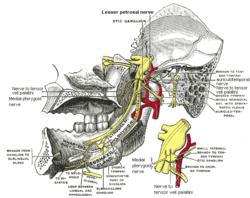Inneuroanatomy, the mandibular nerve (V3) is the largest of the three divisions of the trigeminal nerve, the fifth cranial nerve (CN V). Unlike the other divisions of the trigeminal nerve (ophthalmic nerve, maxillary nerve) which contain only afferent fibers, the mandibular nerve contains both afferent and efferent fibers. These nerve fibers innervate structures of the lower jaw and face, such as the tongue, lower lip, and chin. The mandibular nerve also innervates the muscles of mastication.[1]
| Mandibular nerve | |
|---|---|

Mandibular division of the trigeminal nerve.
| |

Mandibular divisionoftrigeminal nerve, seen from the middle line. The small figure is an enlarged view of the otic ganglion.
| |
| Details | |
| From | Trigeminal nerve (CN V) |
| Identifiers | |
| Latin | nervus mandibularis |
| MeSH | D008340 |
| TA98 | A14.2.01.064 |
| TA2 | 6246 |
| FMA | 52996 |
| Anatomical terms of neuroanatomy | |
The large sensory root of mandibular nerve emerges from the lateral part of the trigeminal ganglion and exits the cranial cavity through the foramen ovale. The motor root (Latin: radix motoria s. portio minor), the small motor root of the trigeminal nerve, passes under the trigeminal ganglion and through the foramen ovale to unite with the sensory root just outside the skull.[2][better source needed]
The mandibular nerve immediately passes between tensor veli palatini, which is medial, and lateral pterygoid, which is lateral, and gives off a meningeal branch (nervus spinosus) and the nerve to medial pterygoid from its medial side. The nerve then divides into a small anterior division and a large posterior division.
The mandibular nerve gives off the following branches:
This section may be confusing or unclear to readers. Please help clarify the section. There might be a discussion about this on the talk page. (August 2023) (Learn how and when to remove this message)
|
Anterior Division
(Motor Innervation - Muscles of mastication)
(Sensory Innervation)
Posterior Division
Lingual Split
(general sensory innervation (not special sensory for taste))
Inferior Alveolar Split
(Motor Innervation)
(Sensory Innervation)
Auriculotemporal Split